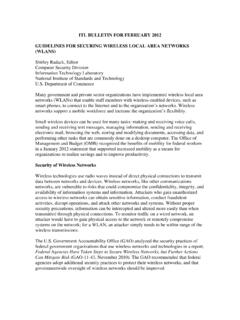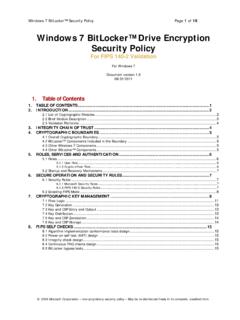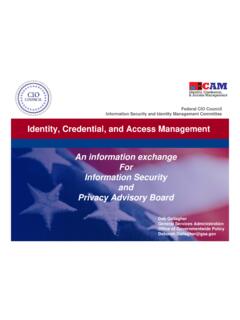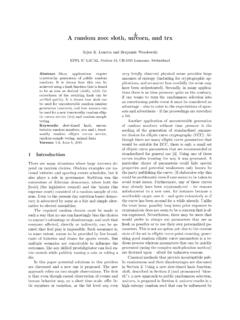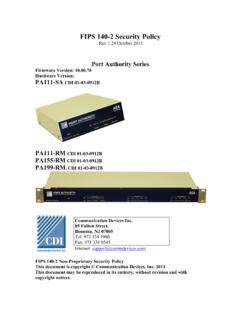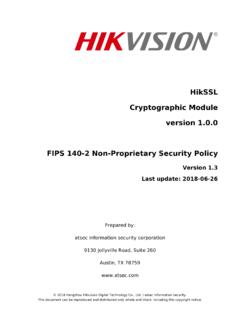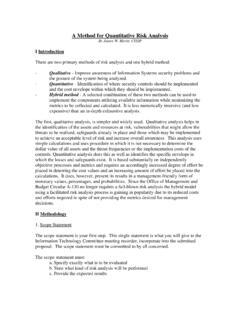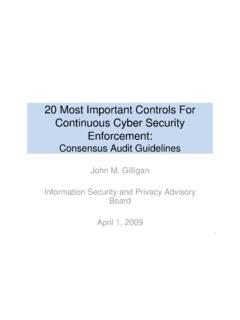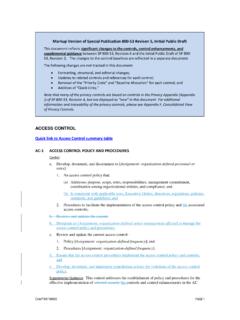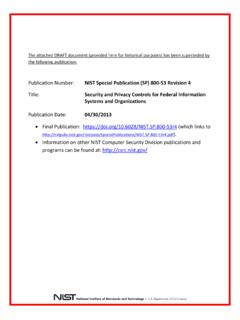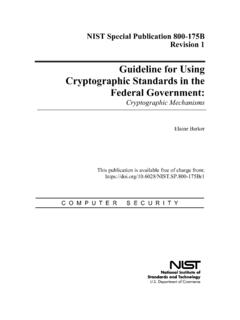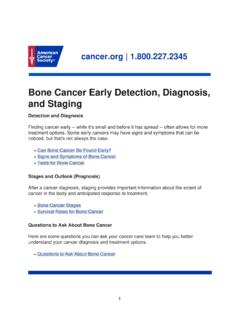Transcription of NIST SP 800-34, Revision 1 - Contingency Planning Guide ...
1 Marianne SwansonNIST SP 800-34, Revision 1 Contingency Planning Guide for Federal Information SystemsNATIONAL INSTITUTE OF STANDARDS AND TECHNOLOGY1 Filename/RPS NumberTable Of Contents Introduction to NIST SP 800-34 Summary of Changes in NIST SP 800-34 Revision 1 NIST Future Plans Questions2 Filename/RPS NumberIntroduction to NIST SP 800-34 National Institute of Standards and Technology (NIST) is responsible for developing standards and guidelines for providing adequate information security for all agency operations and assets . NIST has a series of Special Publications (SP) and Federal Information Processing Standards (FIPS)that provide federal agencies with standards and guidelines for most aspects of information systems security. NIST security Publications can be found at: NIST SP 800-34 Contingency Planning Guide for Information Technology (IT) Systems-was first published in June 2002, and provides instructions, recommendations, and considerations for government IT Contingency Planning .
2 Contingency Planning refers to interim measures to recover IT services following an emergency or system disruption. While designed for federal systems, NIST SP 800-34 has been used as the guideline for Contingency Planning throughout much of the private for the Revision to NIST SP 800-34 Aligns NIST SP 800-53 Rev. 3, Contingency Planning security controls (CP-family). FIPS 199 impact levels Annual testing for FIPS 199 low impact systems Incorporates Contingency Planning into the six phases of the Risk Management Changes to NIST SP 800-34 Filename/RPS Number Revision 1 covers three common types of platforms, making the scope more inclusive (Client/servers, Telecommunications systems, and Mainframes). There is a bigger focus on the Information System Contingency Plan (ISCP) as it relates to the differing levels of FIPS 199 impact levels.
3 General Support Systems (GSS) and Major Applications (MA) categories have been removed. Introduces the concept of resiliency and shows how ISCP fits into an organization s resiliency effort. Works to more clearly define the different types of plans included in resiliency, continuity and Contingency Planning . Throughout the Guide , call out boxes clarify the specific differences and relationships between COOP and is a concept that is gaining widespread acceptance in the continuity and Contingency Planning Department of Homeland Security (DHS) defines resiliency as the ability to resist, absorb, recover from or successfully adapt to adversity or a change in conditions . Resiliency is not a process, but rather an end-state for organizations. Resilient organizations continually work to adapt to changes and risks that can affect their ability to continue critical functions.
4 An effective resiliency program includes risk management, Contingency and continuity Planning , and other security and emergency management NumberThe Goal of A Resilient OrganizationContinue Mission Essential Functions at All Times During Any Type of Disruption6 NIST SP 800-34 Revision 1 provides more clarity to the role and function of various Contingency and continuity plansPlanPurposeScope Plan RelationshipBusiness Continuity Plan (BCP) Provides procedures for sustaining business operations while recovering from a significant business processes at a lower or expanded level from COOP mission essential functions Mission/business process focused plan that may be activated in coordination with a COOP plan to sustain non- mission essential functions . Continuity of Operations (COOP) PlanProvides procedures and guidance to sustain an organization s mission essential functions at an alternate site for up to 30 days; mandated by federal the mission essential functions; facility- based plan; information systems are addressed based only on their support to the mission essential essential function focused plan that may also activate several business unit- level BCPs, ISCPs, or DRPs, as Communications PlanProvides procedures for disseminating internal and external communications; means to provide critical status information and control communications with personnel and the public; not information system plan often activated with a COOP or BCP, but may be used alone during a public exposure event.
5 Critical Infrastructure Protection (CIP) PlanProvides policies and procedures for protection of national critical infrastructure components, as defined in the National Infrastructure Protection critical infrastructure components that are supported or operated by an agency or management plan that supports COOP plans for organizations with CI/KR Number7 NIST SP 800-34 Revision 1 provides more clarity to the role and function of various Contingency and continuity plansPlanPurposeScope Plan RelationshipCyber Incident Response PlanProvides procedures for mitigating and correcting a system cyber attack, such as a virus, worm, or Trojan mitigation and isolation of affected systems, cleanup, and minimizing loss of system focused plan that may activate an ISCP or DRP, depending on the extent of the Recovery Plan (DRP)
6 Provides procedures for relocating information systems operations to an alternate after major system disruptions with long-term system focused plan that activates one or more ISCPs for recovery of individual System Contingency Plan (ISCP)Provides procedures and capabilities for recovering an information plan that focuses on the procedures needed to recovery a system at the current or an alternate system focused plan that may be activated independent from other plans or as part of a larger recovery effort coordinated with a DRP, COOP, and/or Emergency Plan (OEP)Provides coordinated procedures for minimizing loss of life or injury and protecting property damage in response to a physical on personnel and property particular to the specific facility; not business process or information system-based.
7 Incident-based plan that is initiated immediately after an event, preceding a COOP or DRP Number8A new graphic has been developed to better convey the relationships of the different types of plans to the organizationFilename/RPS Number9 The Business Impact Analysis (BIA) was revised to more closely tie to Federal standards and guidelines The process for the BIA has been revised to closely tie to FIPS 199 impact levels and NIST SP 800-53 Rev. 3 Contingency Planning (CP) controls. The BIA process now takes into consideration that impact levels are determined as part of the security categorization process. Federal Information Processing Standard (FIPS 199) - The term Maximum Tolerable Downtime (MTD) is defined and discussed in relation to Recovery Time Objective (RTO) and Recovery Point Objective (RPO).
8 The BIA discussion addresses the differences between BIAs required for systems and those required by Federal Continuity Directives (FCD) -1 and 2 for Continuity of Operations (COOP) Mission Essential Functions (MEF).Filename/RPS Number10 NIST SP 800-53 Recommended Security Controls for Federal Information Systems and Organizations define 9 CP controlsFilename/RPS NumberControl NameSecurity Control BaselinesLowModerateHighCP-1 Contingency Planning Policy and ProceduresCP-1CP-1CP-1CP-2 Contingency PlanCP-2CP-2 (1)CP-2 (1) (2) (3)CP-3 Contingency TrainingCP-3CP-3CP-3 (1)CP-4 Contingency Plan Testing and ExerciseCP-4CP-4 (1)CP-4 (1) (2) (4)CP-5 Contingency Plan Update (Withdrawn)-----------------CP-6 Alternate Storage SiteNot SelectedCP-6 (1) (3)CP-6 (1) (2) (3)CP-7 Alternate Processing SiteNot SelectedCP-7 (1) (2) (3) (5)CP-7 (1) (2) (3) (4) (5)CP-8 Telecommunications ServicesNot SelectedCP-8 (1) (2)CP-8 (1) (2) (3) (4)CP-9 Information System BackupCP-9CP-9 (1)CP-9 (1) (2) (3)
9 CP-10 Information System Recovery and ReconstitutionCP-10CP-10 (2) (3)CP-10 (2) (3) (4)11 Testing, Training and Exercises Section is also more closely linked to other federal Standards and guidelines There is more clarity when defining testing, training and exercises (TT&E). References are included for NIST SP 800-84 Guide to Test, Training, and Exercise Programs for IT Plans and Capabilities - TT&E is also linked to FIPS 199 impact levels. For low-impact systems, a yearly tabletop exercise is sufficient For moderate-impact systems, a yearly functional exercise should be conducted For high-impact systems, a yearly full-scale functional exercise should be conducted. Sample activities are presented to assist in development of effective TT&E programs for Number12TT&E programs and exercise types are defined to address requirements to NIST SP 800-53 Rev.
10 3 security control CP-4 NIST SP 800-53 Rev. 3 Contingency Planning (CP)-4 defines requirements for Contingency plan test and exercise. A Tabletop Exerciseis a Discussion-based simulation of an emergency situation in an informal, stress-free environment; designed to elicit constructive scenario-based discussions for an examination of the existing ISCP and individual state of A Functional Exercise is a Simulation of a disruption with a system recovery component such as backup tape restoration or server recovery. A Full-Scale Functional Exerciseis a Simulation prompting a full recovery and reconstitution of the information system to a known state and ensures that staff are familiar with the alternate facility. Filename/RPS Number13 The flow for steps performed during a Contingency event have been revised in the ISCP development The flow has switched activation and notification steps in the assumption that an ISCP would not be considered for routine downtimes, but would be used for major issues.
